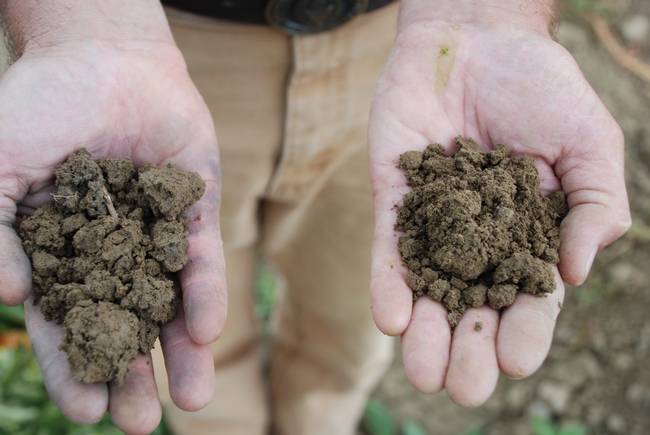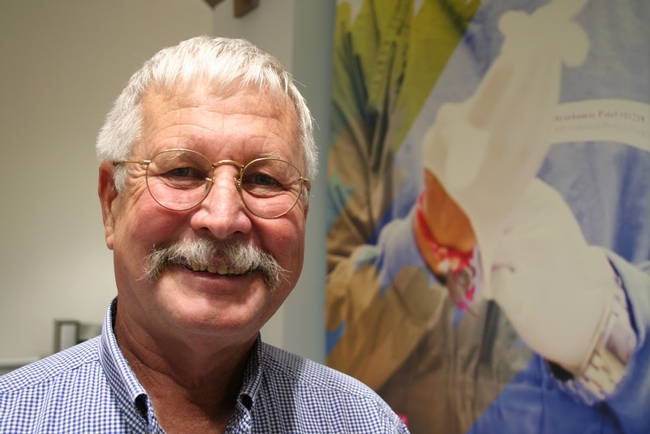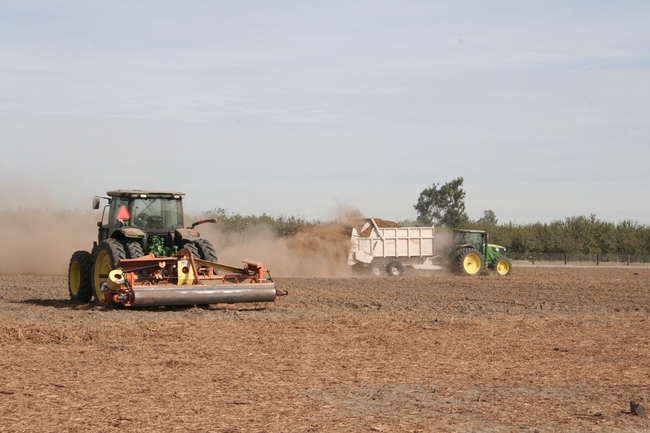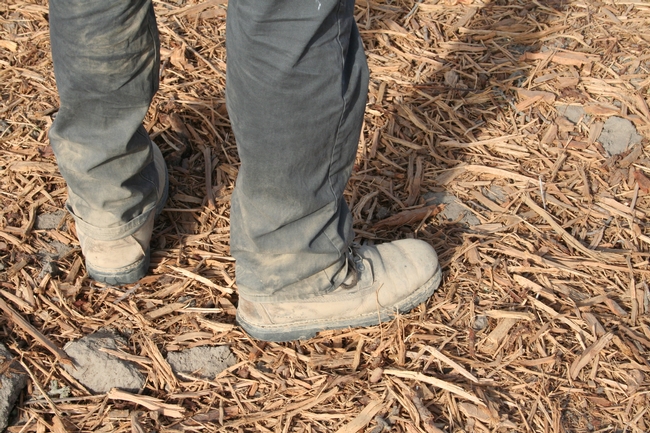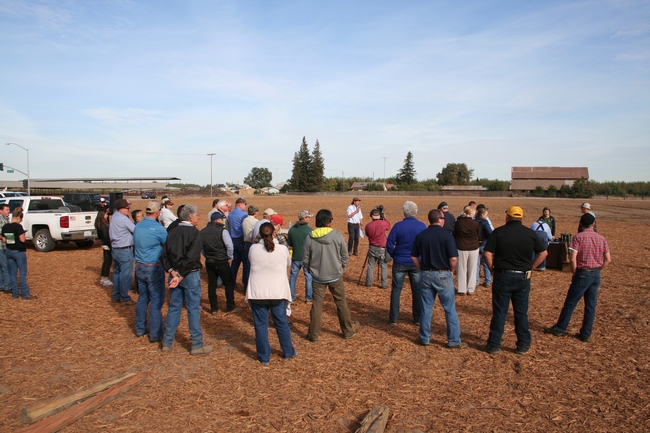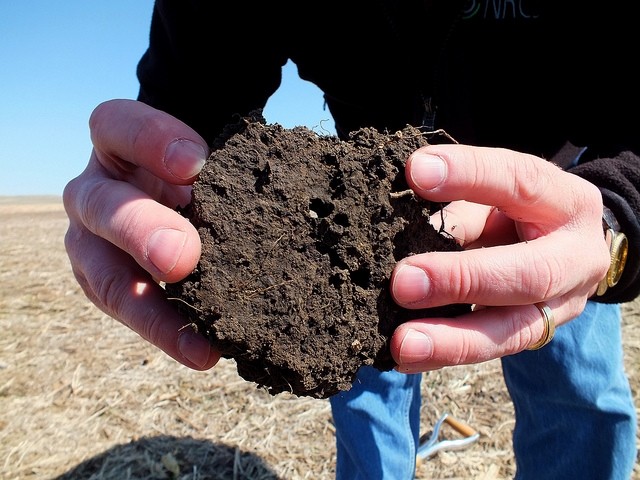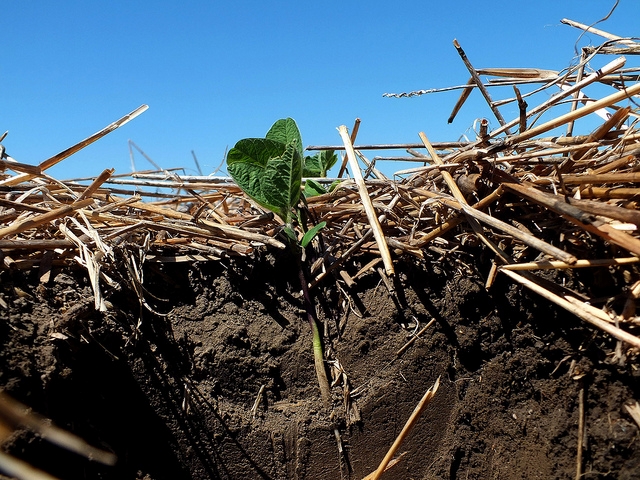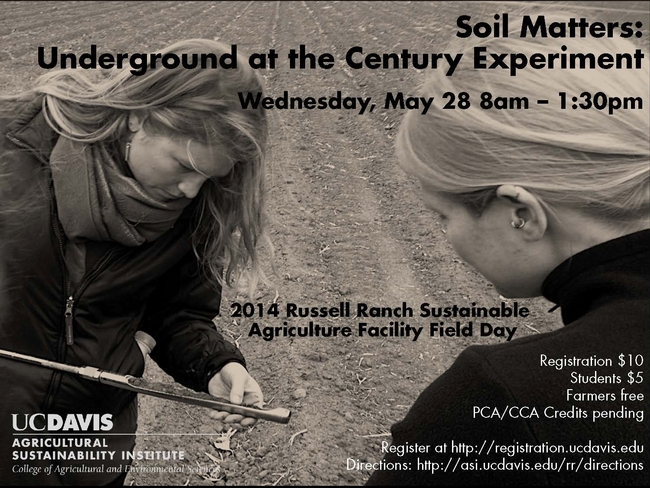Posts Tagged: soil
State funding may help farmers overcome challenges to improved soil practices
Improved soil promises to help farmers use less water and reduce carbon in the atmosphere, reported Ezra David Romero on Valley Edition, a one-hour weekly program that airs on KVPR-FM.
The five-minute story, which begins at the 30:30 mark, focuses on CDFA's new Healthy Soils Initiative. The program is expected to allocate $7.5 million for farmer incentives to use practices that will improve soil health and reduce greenhouse gas emissions. These are practices that are already in place on some innovative valley farmers, including two that are active in the UC Agriculture and Natural Resources' Conservation Agriculture Systems Innovation center.
Jesse Sanchez, manager at Sano Farms in Firebaugh, said 15 years ago, tractors were rolling across the 4,000-acre tomato farm all the time. Now, the farm features cover crops in the winter, reduced soil tillage, irrigation with super-efficient buried drip tape and lower fertilizer needs. The result is a one-third drop in water use and a 75 percent reduction in diesel to fuel tractors, Romero said.
Many of the farm's tractors have been sold. "We don't want to see them no more," Sanchez said.
Retired Madera County farmer Tom Willey discussed the critical importance of soil care he learned as a long-time organic vegetable grower.
"It's the survival of our species," Willey said. "The soil is the thin skin of the earth that we all exist on. Our lives are bound up in the health and productivity of the soil."
UC Cooperative Extension specialist Jeff Mitchell noted the challenges that farmers face in making soil care changes. “A real part of the challenge for California farms is the high-value nature of the production systems, the crops themselves, and some difficult challenges in terms of the diversity of the crops," he said.
Planet-friendly orchard recycling makes money sense
The numbers are beginning to trickle in confirming UC Cooperative Extension advisor Brent Holtz' hunch. Chipping and returning expired almond orchards into the soil where they grew is not only environmentally sound, it is economically smart.
(View a three-minute video of the machinery in action at the end of this post.)
After about 20 years, almond orchards' productivity and vigor begin to decline. Most farmers remove the old trees and plant younger, more vigorous replacements to keep up almond production.
In the past, old trees were easily and cheaply disposed of: they were pushed into a pile and set on fire. Air quality regulations have all but eliminated the practice.
At first, grinding the trees and sending the chips to a co-generation plant was a farmer's preferred option. The companies that used biomass for electricity generation paid an acceptable sum – about $600 per acre – for the wood chips, which helped offset the cost of chipping and hauling the trees off the property.
However today, electrical utilities are looking for clean, renewable energy sources like wind and solar.
“Cogeneration plants burn wood biomass, which still releases carbon dioxide and methane into the atmosphere,” Holtz said. “Many are losing contracts and shutting down.”
Holtz sought another cost-effective alternative, and believes incorporating the wood into the orchard floor may be the answer. Although initially expensive, adding $400 per acre to the $600-per-acre cost of chipping the old trees, the organic matter and nutrients released by the woodchips over time appear to boost yield to a level that covers a chunk of the cost.
In preliminary research, Holtz found that almond orchards where old wood was incorporated into the soil were averaging about 1,800 pounds of meat nuts per acre, while the orchard where old trees had been burned averaged 1,600 meat nuts per acre.
“Almonds sell for about $2 to $3 per pound. To have a 200-pound average yield increase per acre, you've made up the cost of incorporating the wood in just one year,” Holtz said. “It would be even more affordable if farmers can sell carbon credits for the biomass that they sequester in the ground.”
Holtz recently demonstrated two approaches for incorporating almond trees into the soil. The first, which was also used in the study eight years ago at the UC Kearney Agricultural Research and Extension Center in Parlier, is a 50-ton rock crusher called the Iron Wolf. It lumbers down the tree row, grinding up whole trees in place, then reverses over the mangled wood to incorporate it into the ground.
“We thought this one-machine process was the answer,” Holtz said.
G & F Ag Services in Ripon, which has made a business of chipping and hauling almond wood to a co-generation plant, conceived another plan. It modified a manure spreader to spray ground-up wood chips across the orchard floor. Holtz worked with Manteca farmer Louie Tallerico to give the new process a spin.
“This required five different machines working together compared to one Iron Wolf. In this process, the trees have to be excavated by an excavator, then hauled to the wood chipper with a front-end loader. The trees have to be fed into the wood chipper, then the wood chips have to be spread on the orchard floor,” Holtz said. “Another machine, a disk or roto tiller, incorporates the chips into the soil.
The five machines combined are a tremendous time saver.
“The Iron Wolf could do about two acres per day,” Holtz said. “This process can do 15 or 20 acres per day.”
Tallerico opened his farm for a field day in October to demonstrate parts of the process to other farmers and industry representatives. Participants stood on layer of fresh-cut wood chip mulch where a full-grown almond orchard stood just weeks before. The spreader demonstrated the ease with which the wood chips are dispersed evenly across the orchard floor, and a tiller mixed the wood chips into the soil.
The Tellarico orchard will now be the site of research – funded by the California Almond Board – to be conducted by Holtz and a team of scientists interested in documenting the growth and development of the new almond orchard among the remnants of its predecessor.
“In the previous study, three years after incorporating the old trees into the soil we started to see the nutrient benefit,” Holtz said. “This was done at Kearney, where we incorporated a peach orchard that had about 30 tons of organic matter per acre. Almond trees are larger, so here we have 86 tons of organic matter being returned to the soil.”
In the new study, the scientists will determine whether the nutrient benefits found in early research still hold true, whether the wood chips in the soil stunt the new orchard or boost its growth, whether the new orchard suffers from replant disease, and the fate of good and bad nematodes (tiny soil-borne worms) in the new orchard.
“We will also study the carbon budget and continue the life cycle assessment of almond with this practice, to better understand the benefit of these processes,” Holtz said.
International Year of Soils celebrates a life-sustaining natural resource
“Soil is a life-sustaining natural resource that often goes unnoticed,” said Anthony O'Geen, UC Cooperative Extension soil specialist in the Department of Land, Air and Water Resources at UC Davis. “But soil is fundamental for production of food, animal feed, fuel and natural fiber as well as performing many critical ecosystem functions, like filtering water, cycling nutrients and maintaining biodiversity.”
Moreover, soil is an extremely limited natural resource. Three-quarters of the earth is covered by water. Half of what's left is desert, swamps, frozen solid or mountainous – areas unsuitable for agricultural production. Land that's rocky or floods annually further reduces space for growing crops, leaving just a tiny fraction of the earth's surface as arable land.
These limited areas of productive soils on earth are threatened by expanding urban development, unsustainable soil management practices, pollution and overgrazing. Other natural resources – like air and water – garner more attention as they enjoy much greater visibility, while soil is kept in the dark and treated like dirt. UC Agriculture and Natural Resources is taking part in the year-long celebration of soil to help give soil the recognition it deserves and promote policies that will protect the earth's soil for future generations.
O'Geen is the chair of the Soils and Biochemistry Graduate Group at UC Davis. As a UCCE specialist, he said, he is trying to get students more involved in outreach and sees the International Year of Soils as an ideal rallying point for 2015. The graduate students kicked off the Year of Soils in December by sponsoring a “PED Talk” competition. (Ped is a scientific term for an aggregate of soil. It was selected in a nod to the world-famous TED Talks.)
Graduate student Katy Dynarski won first prize and $250 for her five- minute talk titled “I ♥ soil.”
“We're continuously taught throughout our lives that soil is something bad,” said Dynarski in her presentation. “You ‘soil' your reputation. You keep ‘dirty' secrets.… In this way, we create a fundamental disconnect between ourselves and soil and we are able to banish it to the realm of things that just don't matter.”
Another student, Jessica Chiartas, invoked the world's celestial connections in her presentation.
Messages about the significance of soil conservation will be shared with California state legislators at Ag Day at the Capitol in Sacramento on March 18. An annual celebration of the state's diverse agricultural industry, the event draws farmers, 4-H members, commodity groups and agencies who work with the state's agriculture industry – including the UC Division of Agriculture and Natural Resources – to the state capitol's front steps. Elected officials, their staff, California state workers and the public visit and learn about California agriculture.
Other UC activities marking the International Year of the Soils are aimed at extending to farmers ways they can preserve and protect the soil on their California farms. The Conservation Agriculture Systems Innovation Center (CASI) – a collaborative project coordinated by UC that involves farmers, researchers and representatives of public and private agencies and environmental groups – is a leader in promoting soil health. The group conducts research and extension activities aimed at helping landowners maintain and improve their farms' productivity with soil management systems like cover crops, reduced tillage and no-till, and crop rotations. These systems are intended to cut sediment loss from farms and ranches, reduce dust emissions, conserve water and sequester carbon.
CASI has outlined three soil-health initiatives to accomplish during the International Year of Soils. The group will hold a series of demonstration evaluations and information-sharing field events throughout the year. The soil health outcomes from the long-term conservation agriculture and cover cropping research project at the UC West Side Research and Extension Center will be presented to 100 different audiences. A 10-segment soil health video series will be developed along with the USDA's Natural Resources Conservation Service.
The videos will present the underlying theory and principles of soil health with particular emphasis on conditions in the Central Valley. It will include vignettes about local farmers who have successfully improved soil function on their land while lowering production costs.
“Too often it seems that a big part of the information we get on soil health comes from far away in regions not at all like what we have in California,” said Dennis Chessman, NCRS state agronomist headquartered in Davis. “What we really need are examples of what works right here in the Central Valley and that's what we're trying to now develop.”
Mitchell, who has devoted his 20-year career to researching and promoting practices to improve soil health, said the International Year of Soils is adding momentum to ongoing complimentary soil health efforts in the U.S. and worldwide that have been building slowly for years.
“We need healthy soils now and in the future to provide a secure food supply to the world population,” Mitchell said. “The International Year of the Soil will help us reach the public with this fundamental work.”
An initiative to maintain and enhance sustainable natural ecosystems is part of UC Agriculture and Natural Resources Strategic Vision 2025.
A day in the life of a 100-year agricultural experiment
It's not every day that you can take a guided tour of a 100-year-long scientific experiment, but that's what is happening May 28 as UC Davis hosts a field day at the Russell Ranch Sustainable Agriculture Facility.
The 72-acre “Century Experiment” at Russell Ranch is exploring the long-term impacts of crop rotation, farming systems, and inputs of water, nitrogen, carbon, and other elements on agricultural sustainability. Researchers document trends affecting crop yields, soil quality, profitability, environmental impacts, and efficiency in use of limited resources.
“We look at both organic and conventional systems,” says Russell Ranch director Kate Scow, a professor in the Department of Land, Air and Water Resources at UC Davis. “We're continuing to learn how to better manage both systems in the long term, but it's also important to identify new farming systems that incorporate the best parts of both.”
The theme for the May 28 event is “Soil Matters: Underground at the Century Experiment.” Presentations will be made by faculty, farmers, graduate students, postdoctoral researchers, and visiting scholars. Topic areas include:
- Nitrate leaching, drought and irrigation management in agriculture
- Soil biology — microbial communities and impact on farming systems
- Biochar — carbon sequestration and nutrient impacts
- Soil nutrient budgets and management
The program gets underway at 8:00 a.m. with welcoming remarks, followed by a tour of research sites from the comfort of hay-bale wagons. Presentations move indoors to the barn at 10:30 a.m. A growers' panel discussion follows lunch. The program wraps up at 1:30 p.m.
Registration is $10 ($5 for students, free for farmers) and can be made online through May 26. Russell Ranch is located approximately six miles west of the main UC Davis campus.
Russell Ranch, part of the Agricultural Sustainability Institute in the College of Agricultural and Environmental Sciences, is a unique 1,500-acre facility with more than 300-acres dedicated to the study of dry-land agriculture in a Mediterranean climate. The crops grown there — tomatoes, corn and wheat — are the same crops grown in the region. Researchers have monitored changes in crop and soil properties, greenhouse gas emissions, weed ecology, and economic indicators there since 1993.
Among research highlights, scientists have shown that cover-cropped systems can be managed to store water in the soil, tomatoes grown with subsurface drip irrigation use less water and less nitrous oxide emissions, and the concentration of antioxidant compounds are higher in organic than conventional tomatoes.
“We may need to make some hard choices about water and nutrient inputs that could change the face of what we currently know as California agriculture,” Scow says. “So we need resilient systems that can endure and be productive in a changing and unpredictable climate.”
For additional information about the field day, contact Emma Torbert at eetorbert@ucdavis.edu or (530) 752-5208.
Plants for Clay Soil and Other Things
Today while going through my e-mail, one of them really caught my eye. It was the monthly newsletter from BIRDS & BLOOMS, a magazine dedicated to those who both garden and bird-watch. I first came across this magazine when my mother, who subscribed, gave me her copies. I always thought of it as one of those publications for the “older set” and didn’t give it much thought. After mom passed, the subscription still had 3 years left, so I kept getting it. The more I read it, the more interesting this magazine became!
So here it is 2013 and now I have my own subscription that is complimented by this monthly on-line feature. Sometimes the features are on target and other times they are not –when not, it’s usually big time: articles that pertain to the Mid West only.
Imagine my surprise when the topic for this month is “Plants for Clay Soil”. I had to read the article thoroughly in case it held nuggets of wisdom I should -- nay, must have! I feel better now, since most of the plants listed are in my yard! Asters were the first on their list (which is only correct as these plants are listed alphabetically). Not only it common name; botanical name (a real plus when you are actually looking for the listed plants!); hardiness, bloom season; size ( that’s another big plus to the list); flowers, both colors and shape; light needs; growing advice (this is necessarily somewhat vague when you consider that this advice is trying to cover the entire USA, but you can tweak it according to where you happen to be); and, finally, what is called the “prize picks” or listing of what the editors consider to be the best variety.
Of the plants selected, I have the day lily (hemerocallis), switchgrass (Panicum virgatum) Viburnum (Viburnum sps), and various ferns including the squirrel’s foot fern (Polypodiumspp.), which hangs from a piece of all-thread screwed into the pergola . Potentilla (Potentilla fruitcosa) is a favorite as a small ground cover in the side yard, running into the baby’s tears (Soleirolia soleirolii).
The entire list is Aster, Black-eyed Susan, Coreopsis, Daylily, Ferns, Japanese Iris (mine died a very painful death, at least to my wallet), Runner bean, Switchgrass, Potentilla, and Viburnum. How many do you have in your yard?
PS: To those of you who noticed that the Switchgrass was listed before the Potentilla, it’s because using botanical names, Panicum comes before Potentilla!
Now to go and unwrap and plant my new rose from Vintage Gardens. The last sale – until the management announces another release before they go out of business for good!
PPS: I guess I have joined the “older set”!
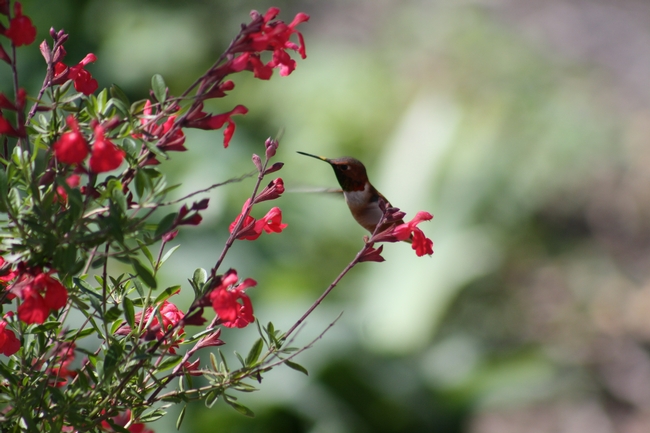
Rufous hummingbird visiting a 'Lipstick' sage. (photo by Jennifer Baumbach)


